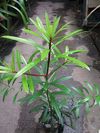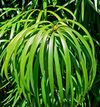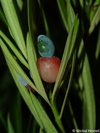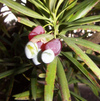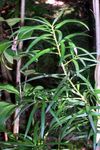Genus Podocarpus
Podocarpus is a genus of conifers, the most numerous and widely distributed of the podocarp family Podocarpaceae.Species in the genus Podocarpus of plants
Podocarpus alpinus - It has tolerated to about -25°C in the British Islands, lower temperatures than all ever recorded in its natural habitat. It needs heavy rainfalls. Slow-growing plant.
Podocarpus aristulatus - Podocarpus aristulatus grows to 10-20 m tall. The leaves are elliptical to linear, 2-4 cm long and 5-8 mm broad, arranged spirally on the shoots. The seed cones are berry-like, with fleshy red receptacle and one apical seeds 7-10 mm long.
Podocarpus brassii - Podocarpus brassii is a species of conifer in the Podocarpaceae family. It is found in Indonesia and Papua New Guinea.
Podocarpus cunninghamii - It is found only in New Zealand.
Podocarpus dispermus - Podocarpus dispermus is a species of conifer in the Podocarpaceae family. It is found only in Queensland, Australia.
Podocarpus drouynianus - Ideally Podocarpus drouynianus should be grown in partial shade with plenty of water. Unusually for the genus, it tolerates quite dry conditions. It survives temperatures of up to 45 °C, and grows well in full sun or partial shade.
Illawarra Plum-pine - It is a medium-sized to large evergreen tree growing to 30-36 m tall with a trunk up to 1.5 m diameter. The leaves are lanceolate, 5-15 cm long and 6-18 mm broad. The seed cones are dark blue-purple, berry-like, with a fleshy base 2-2.5 cm diameter bearing a single oval or globose seed 1 cm in diameter.
Podocarpus elongatus - It is found only in South Africa.
Podocarpus grayae - Podocarpus grayae is a species of conifer in the Podocarpaceae family, endemic to Australia. It is found only in the Northern Territory and Queensland
Podocarpus guatemalensis - Podocarpus guatemalensis is shrub and small tree found in namesake Guatemala, and also from southern Mexico through Belize, Costa Rica, El Salvador, Honduras, and Panama in Central America, to Venezuela and Colombia in northern South America.
Podocarpus henkelii - Podocarpus henkelii is a South African species of conifer in the Podocarpaceae family. It is grown ornamentally in gardens for its strikingly neat, attractive form and its elegant, drooping foliage.
Broad-leaved Yellowwood - It is native to the moister southern and eastern areas of South Africa, from coastal areas of the Western Cape east to KwaZulu-Natal and north to eastern Limpopo. The Real Yellowwood has been declared the national tree of South Africa.
Mountain Plum-pine - The leaves are 1 cm long and 2-3 mm broad, green, often reddish-tinted, particularly so in cold winter weather. It has small bright red berry-like cones, with a 5-10 mm long red aril and one apical seeds 6-8 mm long; they are eaten by birds and marsupials, but are toxic to most other mammals .
Kusamaki - It is a small to medium size evergreen tree, reaching 20 m tall. The leaves are strap-shaped, 6–12 cm long, and about 1 cm broad, with a central midrib. The cones are borne on a short stem, and have 2-4 scales, usually only one fertile, each fertile scale bearing a single apical seed 10–15 mm. When mature, the scales swell up and become reddish purple, fleshy and berry-like, 10–20 mm long; they are then eaten by birds, which disperse the seeds in their droppings.
Podocarpus matudae - Podocarpus matudae is a species of conifer in the Podocarpaceae family. It is found in Guatemala and Mexico.
Podocarpus nivalis - It is one of the hardiest podocarps of the Southern Hemisphere, it has withstood ?25 °C in the British Isles, lower temperatures than all ever recorded historically in its native country. It needs high rainfalls.
Chilean podocarp - It is a medium to large tree, growing to around 20-25 m , exceptionally to 35 m . The bark peels off in papery flakes, with a purplish to golden brown hue. The sharp, green needle-like leaves are stiff and leathery, 2 cm long. The cones are highly modified with 2-4 fused, fleshy berry-like juicy scales, bright red when mature, bearing one rounded seeds at the apex of the scales.
Podocarpus pallidus - It is found only in, and so endemic to Tonga in the South Pacific.
Parlatore's podocarp - It is a medium-sized to large evergreen tree. The leaves are 5–12 cm long, with a blunt apex.
Podocarpus pilgeri - Podocarpus pilgeri is a species of conifer in the Podocarpaceae family. It is found in Cambodia and Thailand.
Podocarpus salignus - It is a very ornamental tree that is very planted in gardens and parks of Chile and has been introduced to the British Isles. It needs very heavy rainfalls. It withstands temperatures down to ?25 °C . The wood has good quality, is yellowish colored, straight grained, highly moisture resistant. It is used in furniture and construction.
Podocarpus smithii - Podocarpus smithii is a species of conifer in the Podocarpaceae family. It is found only in Queensland, Australia.
Podocarpus spinulosus - It was first described by James Edward Smith in 1817 as Taxus spinulosa.
Podocarpus totara - The t?tara is a medium to large tree which grows slowly to around 20 to 25 m, exceptionally to 35 m; it is noted for its longevity and the great girth of its trunk. The bark peels off in papery flakes, with a purplish to golden brown hue. The sharp, dull green needle-like leaves are stiff and leathery, 2 cm long. This plant produces highly modified cones with 2 to 4 fused, fleshy berry-like juicy scales, bright red when mature. The cone contains one or two rounded seeds at the apex of the scales.
Podocarpus trinitensis - Listed as Data Deficient by the IUCN,

